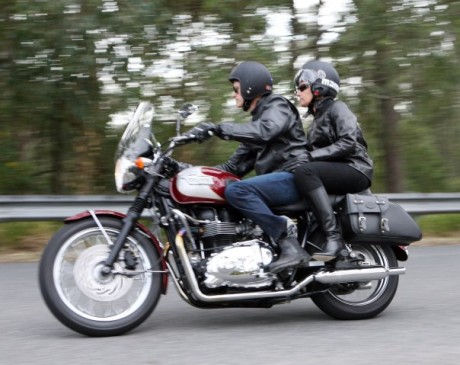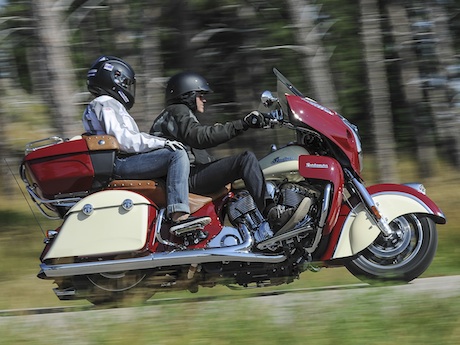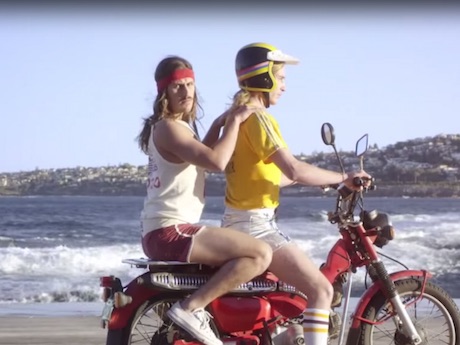Check out the hilarious video about being a pillion or “riding bitch”. Then read our serious tips on the joys of sharing your ride with someone else.
My first pillion ride was also the first time I did the old ton (100mph or 160km/h) on a bike.
It was 1974-ish and my flared Amco jeans were whipping my legs into a frenzy, my Bell helmet was trying to strangle me, my nylon army parker was tearing the flesh from my upper body and I felt like I had one foot in the door at the pearly gates.
The rider was in a race crouch over his Kwaka Z900 leaving me fully exposed to the full blast of the wind which is pretty severe at that speed.
I should have been crouched over as well, hanging on to him, but my misguided machismo meant I didn’t want to hug the guy, so I sat bolt upright and clung on for dear life. Exhilarating and utterly terrifying.
Few riders have ever been a pillion and therefore don’t understand the sheer terror of not being in control.
So if you want to take a pillion, the first tip is to be a pillion and experience it first hand.

Here are some other tips for pillion riding:
1: The right bike.
The general rule is that the more comfortable they are, the better.
But that doesn’t mean you can only carry a pillion if you own a Gold Wing or Ultra Classic.
Perhaps the most enjoyable pillioning my wife and I have ever done was on a Triumph Bonneville T100.
She prefers light bikes because she feels I’ll be able to hold it up. She also prefers they aren’t too powerful and intimidating. The Bonne is also low enough for to just throw a leg over, rather than having to step on the footpeg and hoist over.
But there is no use buying a bike your regular pillion will hate, so ask their opinion. They may actually prefer the budgie perch of a sportsbike because it satisfies their desire for sportiness over comfort.
That means lots and lots of test rides together.
2 Mounting and dismounting.
Advise your pillion to ask permission before hopping on so you have a good hold of the bars and both feet on the ground. Don’t try to do this on the side stand as you may bend it, nor the centre stand as you may not be able to rock the bike to get it back down.
Request your pillion to alight as soon as you stop, then park your bike without them. Don’t be a hero and try to do it with a pillion on board unless you are certain of your abilities and the ground surface. If you drop it, you will quickly go from hero to zero.

3 Exhaust warning.
Warn your pillion about putting their foot or leg on the hot exhaust. Nothing spoils a two-up trip more than a quick visit to the emergency ward to treat a leg burn.
4 Don’t scare your pillion.
They won’t have any trust in you if the first time you take them for a ride you hoist it up on one wheel or whittle down your knee sliders in the corners.
As their level of trust rises, you may add these to your repertoire, but always give them a tap on the leg first to broadcast that you are about to do a wheelie (easier with a pillion) or go for a radical lean angle.
5 Communicate.
Rider and pillion communication used to consist of hand signals or, more likely, a vice-like thigh grip from your pillion when they are scared or a whack on the back of the helmet when they want you to stop and let them off.
Agree on a set of signals before you even put on your helmets and mount the bike. You’ll need signals for when you can mount, hazard coming up (bump, sharp turn etc), slow down, speed up, stop, and when to get off.
If it all sounds too complicated, get a Bluetooth communications system. It not only clears up any confusing hand signals, but also means you can enjoy a chat with your pillion.
6 Be smooth.
Anyone who has ever carried a pillion will be aware of “helmet bump”.
As you accelerate, your pillion tenses their stomach muscles and pulls themselves forward. Your pillion doesn’t know when you are going to change gears, so they stay tense. As soon you dip the clutch,momentum slightly lags and they naturally rock forward, banging their helmet into yours.
There are two ways you can prevent this.
First is to be smooth with your gear changes. The second is to move your head and shoulders forward as you pull the clutch in, leaving the lower part of your back as a buffer to soak up your pillion’s forward movement.
After a while, most pillions learn to listen to the engine revs and brace themselves for the coming gear change.

7 To lean or not to lean.
Of course, pillions shouldn’t lean opposite to the rider.
But some riders tell their pillion to lean into the corner with them.
I don’t agree as you never know how much they will lean and therefore how tightly the bike will corner.
It’s best to tell them to remain fairly still throughout your journey. In fact, advise your pillion that any fidgeting can cause instability and a possible topple, especially at slow speeds and when stopped at the traffic lights.
8 Suspension adjustment.
Most bikes have their suspension set at the factory for the “standard rider” weight of about 80kg. If you weigh substantially more or less, you should make suitable adjustments to the suspension.
However, a pillion changes the load even more significantly. A rider might vary several kilograms above or below the standard rider weight, but a pillion can more than double that difference.
Also, the centre of gravity is now much higher and further back, which will upset the handling and make the steering light.
If your bike has suspension adjustment, make sure you use it. Usually pumping up the preload on the rear spring is enough.
If there is no adjustment and you are going to be doing a lot of two-up riding, it is wise to fit an adjustable rear shock.
Other areas that may need adjustment include the tyres, chain and headlights. Consult your manual for ideal tyre pressures for two-up and how to adjust the chain and headlight beam.
You can reduce handling and steering anomalies by asking your pillion to sit as close as possible to you. Then you will move together in harmony with the bike and better focus the bike’s centre of gravity. But be aware this will prevent you moving around in your seat and you will have to adjust your riding style to suit.
9 Braking.
A pillion‘s weight will also reduce braking efficiency.
Not only will the bike take longer to stop, but in a panic situation, your pillion may be flung on to your back. You not only have to support all your weight on your wrists, but also the weight of your pillion. This can cause riders to lose grip on the bars with inevitable consequences.
Also, the rearward weight bias will make the rear brake more effective and less likely to lock up, so use it more.
10 Gear up.
Just as riders should always wear the right gear, so should pillions.
Your pillion deserves the same level of equipment protection as you.
That also means warm gear when it’s cold, hot weather gear for summer and wets for when it rains.
Riders should also be aware that they block much of the breeze from their pillion, so in summer your pillion is going to need even better ventilated gear.
In winter, riders get some comfort from the heat that comes off the engine, but their pillion may not, so it’s advisable they rug up even more than you.
Bike accessories are also important to a pillion. Luggage will allow them to bring an extra pair of high heels and cocktail dress with them and a sissy bar will provide extra confidence.
However, a loud aftermarket pipe might just be too annoying. Remember, they are a lot closer to it than you. At least put the baffle plug in when carrying a pillion.
- Do you have any other tips?



